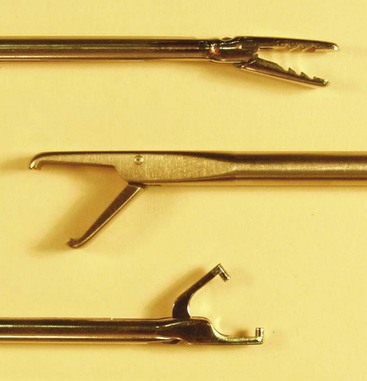Chapter 3 The advent of the suture anchor has dramatically expanded the options for tissue repair. Numerous suture anchor designs are available; anchors come in multiple sizes, allowing maximum fixation strength of tissue to bone.2 Anchors may be made of metal, absorbable material, or plastic and should allow for sutures to slide easily through the eyelet. The anchor, when inserted into the bone, allows suture to be passed through soft tissue and affixed to the desired anatomic location in a predictable fashion. Multiple sutures may be preloaded into the anchor, allowing for multiple points of soft tissue fixation and decreased load on each suture knot.3 Although the choice of the best anchor for each surgical procedure is beyond the scope of this chapter, a basic understanding of anchor types is advised. Arthroscopic cannulas allow for suture passage through tissues, avoiding incorporation of unwanted soft tissue in the repair constructs.4 Sutures and instruments that are not passed through a cannula can be trapped in soft tissues, causing significant difficulty in knot tying, which may result in increased operative times, less secure fixation, and generalized frustration for the surgeon. Cannulas also allow the surgeon to keep sutures organized, prevent suture entanglement, provide easy access to the joint, and facilitate visualization. The ideal cannula size to allow for passage of typical arthroscopic instruments is 8.5 to 10 mm. Cannulas are important tools that play an integral part in the surgical plan. After insertion of the anchor, specialized instruments will be necessary to assist with management of sutures to facilitate a secure repair.4 Suture retrievers are the workhorse of any arthroscopic procedure (Fig. 3-1). These devices can be locking or ratcheting, and function to grasp the suture. Some devices will securely hold the suture, whereas others secure the suture but allow it to slide in the jaws (suture retrieval forceps, or “loopie”). Suture retrieval forceps can facilitate removal of suture from the joint by allowing it to slide as it is extracted. This prevents the suture limb from sliding through the anchor unintentionally. Another option for suture management is the crochet hook instrument.4 This device allows the surgeon to place the suture at various places within the joint for retrieval and passage. Some crochet hooks have a modification that allows for sutures to be pushed with the tip in addition to being pulled with the hook (“push-me, pull-me”).
Knot-Tying and Suture-Passing Techniques
Instrumentation
Suture Anchors
Cannulas
Arthroscopic Instruments
![]()
Stay updated, free articles. Join our Telegram channel

Full access? Get Clinical Tree


Knot-Tying and Suture-Passing Techniques







